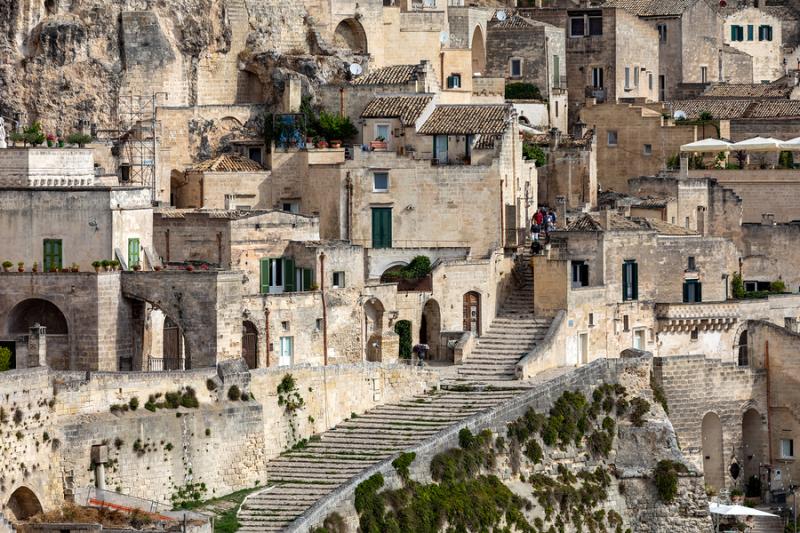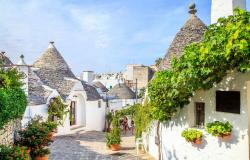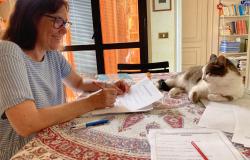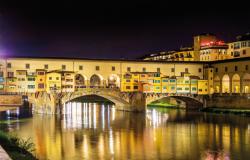Unesco Sites of Italy: The Sassi and the Park of the Rupestrian Churches of Matera
ITA:

Matera, in the southern Italian region of Basilicata, is, in the words of Unesco, which inscribed it in its World Heritage list in 1993, “the most outstanding, intact example of a troglodyte settlement in the Mediterranean region, perfectly adapted to its terrain and ecosystem.”
The Sassi and the Park of the Rupestrian Churches of Matera contains a complex of houses, churches, monasteries and hermitages built into the natural caves of the Murgia, a limestone plateau characterized by deep cracks, ravines, rocks and caves. The site covers an area of 1,016 hectares with more than 1,000 dwellings and several shops and workshops.
The area was first occupied during the Paleolithic period and it has been continuously inhabited for several millennia until the present day. Humans here have always chosen to live in caves, adapting to the environment, harmoniously integrating into the natural terrain and ecosystem; over the millennia, this housing form peculiar to Matera has acquired an exceptional cultural and anthropological value.
The caves are of different shapes and sizes and, over time, they became the foundation over which to raise the first houses, using the same material of the rocks used to dig the caves. This resulted in clusters of houses in the tones of gray and white that can barely be distinguished from the rocks in which they are inserted.
The typical house inside the Sassi di Matera is arranged on three levels, including the stable, the cellar and the cistern. In most cases rooms were of mixed use; it was very common for people to share space with animals.
The houses in the Sassi were abandoned starting in 1952 and today, many of them have been transformed into hotels and accommodation facilities, giving the chance to tourists to experience the atmosphere of life in a cave.
The Park of the Rupestrian Churches includes more than 150 examples of these buildings, which can be traced back to medieval monastic culture, starting in the 8th century. They often include frescoes or bas-reliefs, and represent an important sacred art heritage.
Matera, situata nella regione meridionale italiana della Basilicata, è, secondo quanto scrive l'Unesco, che l'ha inserita nell’elenco Patrimonio Mondiale dell’Umanità nel 1993, “l'esempio più straordinario e intatto di un insediamento troglodita nella regione mediterranea, perfettamente adattato al terreno e all’ecosistema”.
I Sassi e il Parco delle Chiese Rupestri di Matera contengono un complesso di case, chiese, monasteri ed eremi costruiti nelle grotte naturali della Murgia, un altopiano calcareo caratterizzato da profonde spaccature, burroni, rocce e grotte. Il sito si estende su una superficie di 1.016 ettari con oltre 1.000 abitazioni e numerosi negozi e botteghe.
L'area fu occupata per la prima volta durante il Paleolitico ed è stata ininterrottamente abitata per diversi millenni fino ai giorni nostri. Gli esseri umani qui hanno sempre scelto di vivere in grotta, adattandosi all'ambiente, integrandosi armoniosamente nel terreno naturale e nell'ecosistema; nel corso dei millenni, questa forma abitativa peculiare di Matera ha acquisito un eccezionale valore culturale e antropologico.
Le grotte hanno forme e dimensioni diverse e, nel tempo, sono diventate la base su cui innalzare le prime case, utilizzando lo stesso materiale delle rocce utilizzate per scavare le grotte. Il risultato sono gruppi di case nei toni del grigio e del bianco che a malapena si distinguono dalle rocce in cui sono inserite.
La tipica casa all'interno dei Sassi di Matera è disposta su tre livelli, tra cui la stalla, la cantina e la cisterna. Nella maggior parte dei casi le stanze erano di uso misto; era molto comune per le persone condividere lo spazio con gli animali.
Le case dei Sassi furono abbandonate a partire dal 1952 e oggi molte di esse sono state trasformate in hotel e strutture ricettive, dando la possibilità ai turisti di vivere l'atmosfera della vita in grotta.
Il Parco delle Chiese Rupestri comprende oltre 150 esempi di questi edifici, che possono essere fatti risalire alla cultura monastica medievale, a partire dall'VIII° secolo. Includono spesso affreschi o bassorilievi e rappresentano un importante patrimonio di arte sacra.











